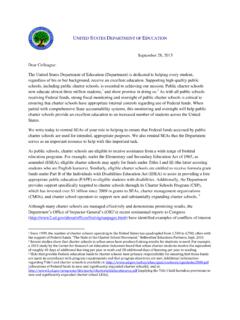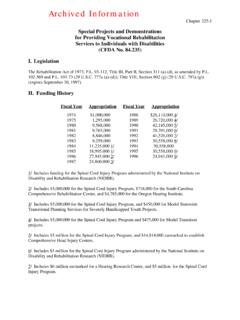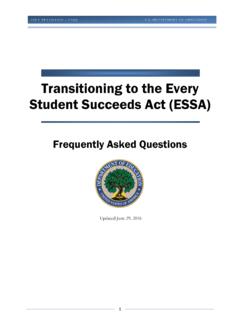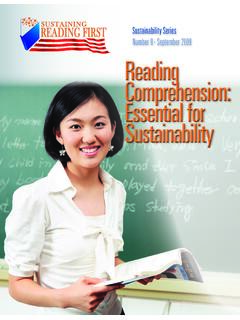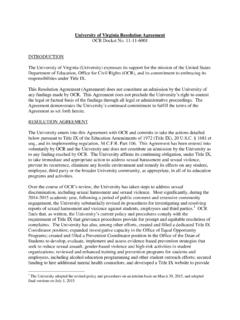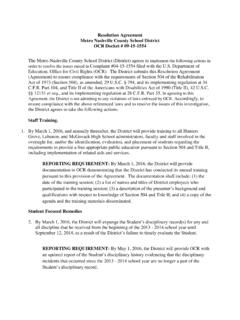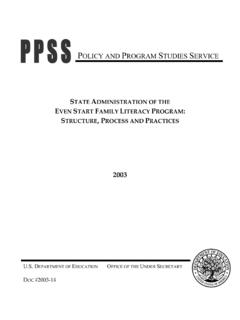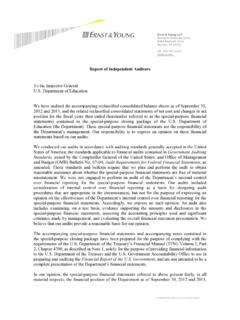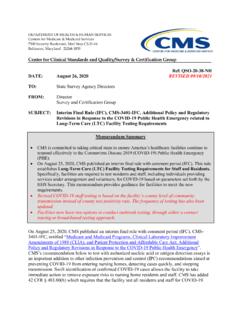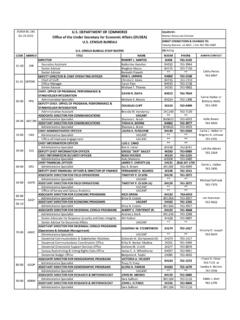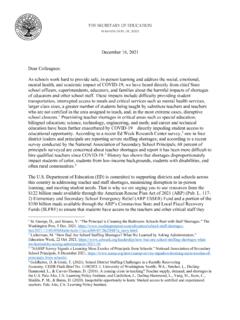Transcription of ED COVID-19 Handbook, Volume 3 - 2021 (PDF)
1 Volume 3 - 2021ED COVID-19 HANDBOOK Strategies for Safe Operation and Addressing the Impact of COVID-19 on Higher Education Students, Faculty, and StaffCOLLEGEOPEPD-IO-21-03 This Volume of the ED COVID-19 Handbook is based on the most recent Centers for Disease Control (CDC) Guidance issued as of June 4, 2021. For the most recent CDC guidance issued after the release of this Volume and how to consider the strategies included in this Volume within the context of the most up to date CDC guidance please visit: DEPARTMENT OF EDUCATION ED COVID-19 Department of EducationDr.
2 Miguel CardonaSecretary of EducationOffice of Planning, Evaluation and Policy DevelopmentDonna Harris-AikensActing Assistant SecretaryJune 2021 This report is in the public domain. Authorization to reproduce it in whole or in part is granted. While permission to reprint this publication is not necessary, the citation should be Department of Education, Office of Planning, Evaluation and Policy Development, ED COVID-19 Handbook, Volume 3: Strategies for Safe Operation and Addressing the Impact of COVID-19 on Higher Education Students, Faculty, and staff , Washington, DC, 2021.
3 This report is available on the Department of Education s website at of Alternate FormatsOn request, this publication is available in alternate formats, such as Braille or large print. For more information, please contact the Department of Education s Alternate Format Center at 202-260-0818 or via e-mail at to Limited English Proficient PersonsIf you have difficulty understanding English, you may request language assistance services for all publicly available Department information. These language assistance services are available free of charge.
4 If you need more information about interpretation or translation services, please call 1-800-USA-LEARN (1- 800- 872-5327) (TTY:1-800-877-8 339), email us at or write to Departmentof Education, Information Resource Center, 400 Maryland Ave., SW, Washington, DC DEPARTMENT OF EDUCATION ED COVID-19 HANDBOOKTABLE OF CONTENTSINTRODUCTION ..4 SAFE PRACTICES FOR IN-PERSON LEARNING ..9 SUPPORTING HIGHER EDUCATION IN NAVIGATING ONLINE LEARNING IN A PANDEMIC ..18 BROADBAND AND DEVICE ACCESS FOR HIGHER EDUCATION STUDENTS, FACULTY, AND staff .
5 25 BASIC NEEDS SUPPORTS FOR STUDENTS ..31 STUDENT CAREGIVERS ..40 MENTAL HEALTH NEEDS OF STUDENTS AND staff ..44 COMMITMENTS TO THE FEDERAL FUNDING AND FLEXIBILITIES ..524 DEPARTMENT OF EDUCATION ED COVID-19 HANDBOOKINTRODUCTIONE very student in America deserves a high-quality education in a safe environment. EXECUTIVE ORDER 14000 SUPPORTING THE REOPENING AND CONTINUING OPERATION OF SCHOOLS AND EARLY CHILDHOOD EDUCATION PROVIDERSP resident Biden is committed to seeking and providing the necessary resources to support the safe operation of institutions of higher education (IHEs) and addressing the ongoing impacts resulting from the COVID-19 pandemic on higher education students, adult education students, faculty, and staff .
6 As stated in Executive Order 14000 (hereinafter referred to as Executive Order), Supporting the Reopening and Continuing Operation of Schools and Early Childhood Education Providers, every student in America deserves a high-quality education in a safe environment. The Biden-Harris Administration strongly believes that increasing capacity for safe in-person learning as soon as possible is essential for students seeking to learn in such a setting. Further, the Administration recognizes the unique challenges faced by IHEs, students, faculty, and staff during these unprecedented times and strives to provide resources and other supports to overcome these challenges.
7 This includes the historic funding provided to IHEs under the American Rescue Plan (ARP).All students, but particularly those in underserved communities, including students from low-income backgrounds, students of color, and students with disabilities, have faced numerous adversities surrounding their postsecondary educational experiences since March 2020, in addition to the direct health impacts from the virus itself. Disparities across communities have been exacerbated and further exposed by the COVID-19 pandemic, and these disparities have shown that some underserved students are less likely to have access to internet services, technological devices, and supports required to participate in remote or hybrid learning, while other students may be enrolled in programs of study for which this option is not feasible.
8 Meanwhile, due to ongoing financial distress or uncertainty, students and families may not have the ability to afford other associated costs of attendance including basic needs such as housing, food, child care, and health insurance. Further, students across higher education may be experiencing ongoing trauma associated with the COVID-19 pandemic including job loss, heightened stress from being an essential worker, full time caretaking of family members, losing loved ones, racial injustice, discrimination experienced by students with disabilities, or experiencing other mental health impacts.
9 Unfortunately, the underlying data confirm that these realities have taken a toll on postsecondary education enrollments, particularly among American Indian or Alaska Native, Black, and Latino (or Hispanic) students, as college-going rates continue to drastically , IHEs have undertaken significant Disparities across communities have been exacerbated and further exposed by the COVID-19 DEPARTMENT OF EDUCATION ED COVID-19 HANDBOOK operational changes and borne great financial costs to continue supporting students amidst rapidly changing health and economic conditions.
10 For example, effectuating a rapid transition to remote learning beginning last spring was a historic undertaking that continues to evolve today. While online learning has been a well-established modality for some programs at IHEs, this was not the primary mode of educational delivery for many IHEs. This transition required additional financial resources, increased and enhanced technology, and rapid cycles of learning and adaptation for students, faculty, and staff . IHEs have also undertaken changes to their physical infrastructure to facilitate social distancing and implement enhanced mitigation protocols and testing regimes.
